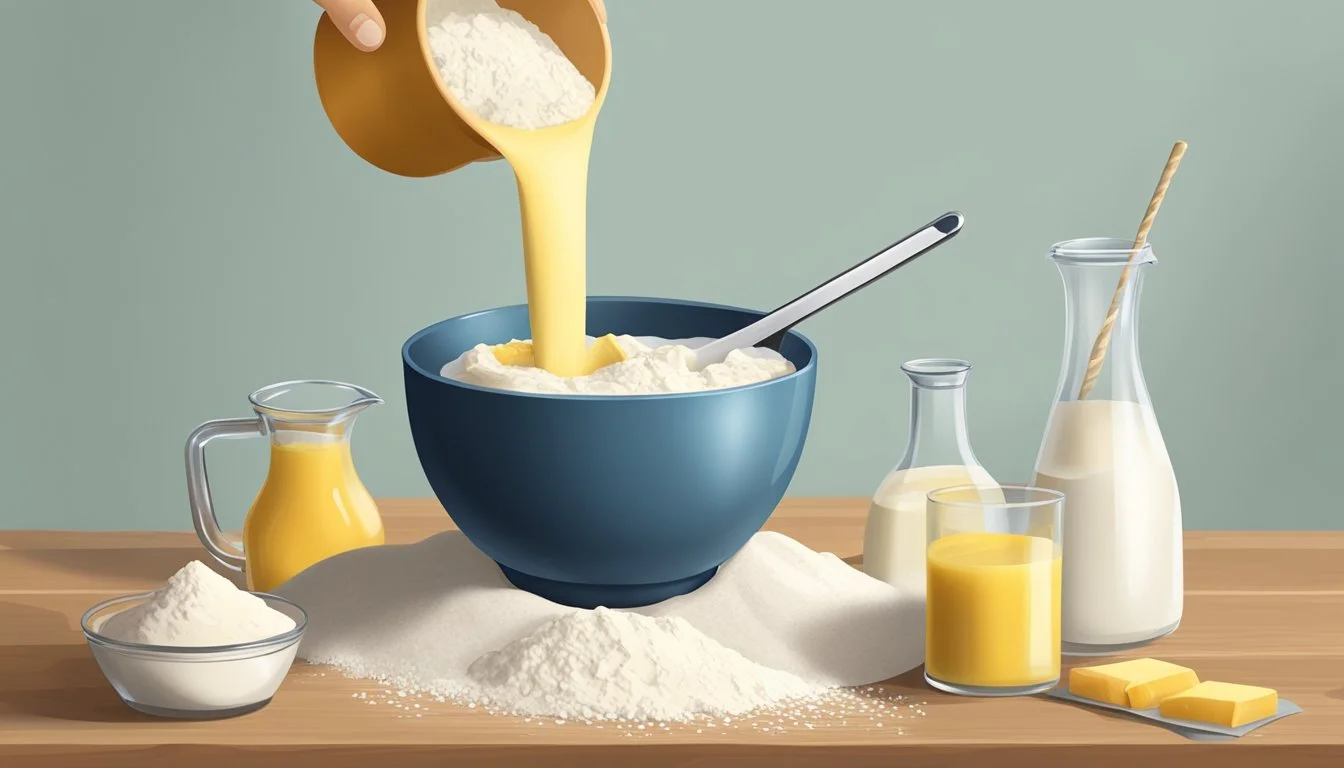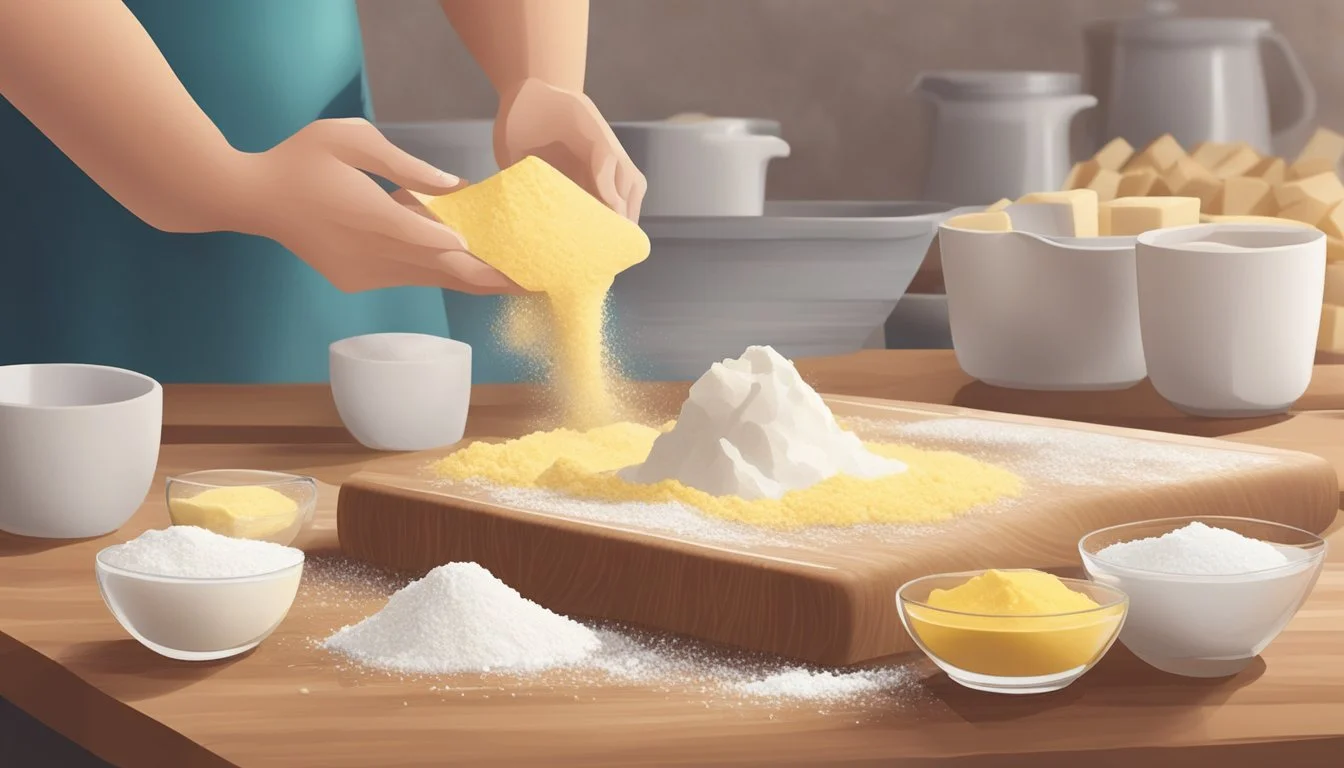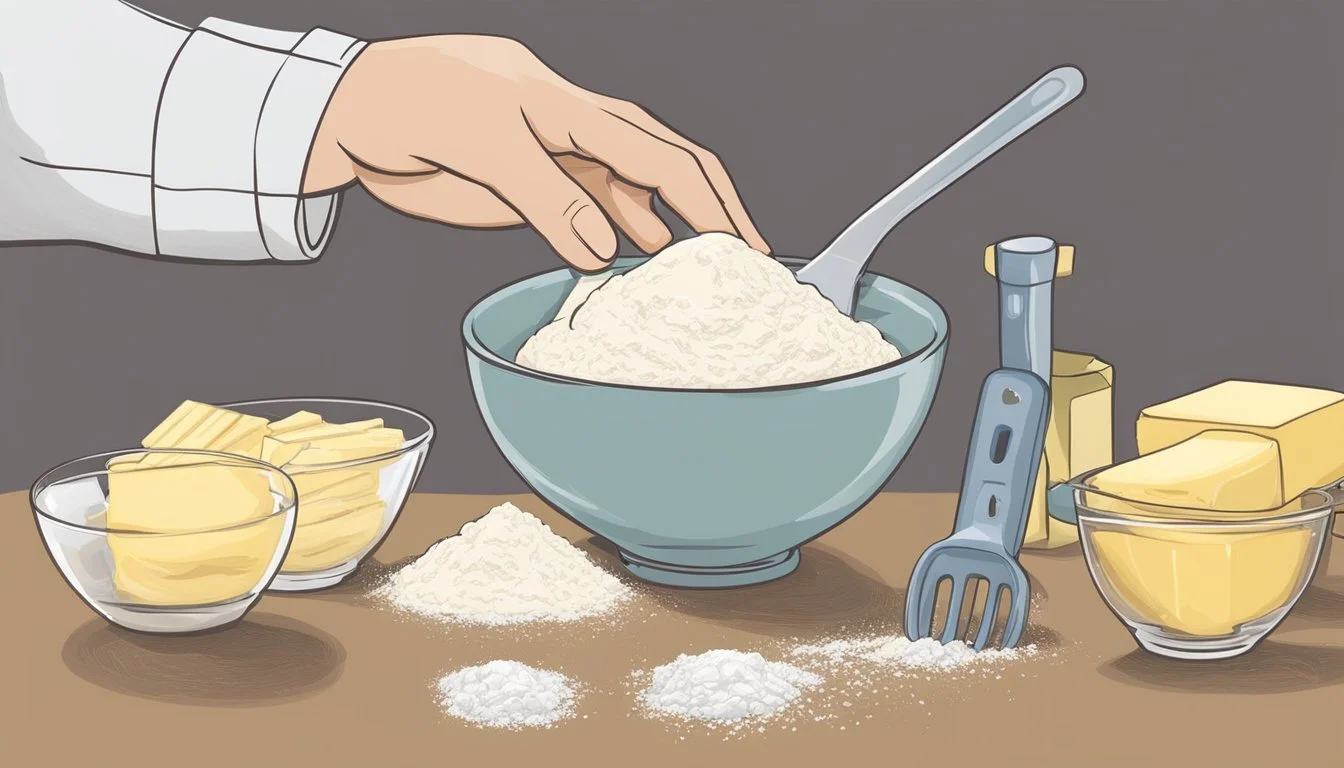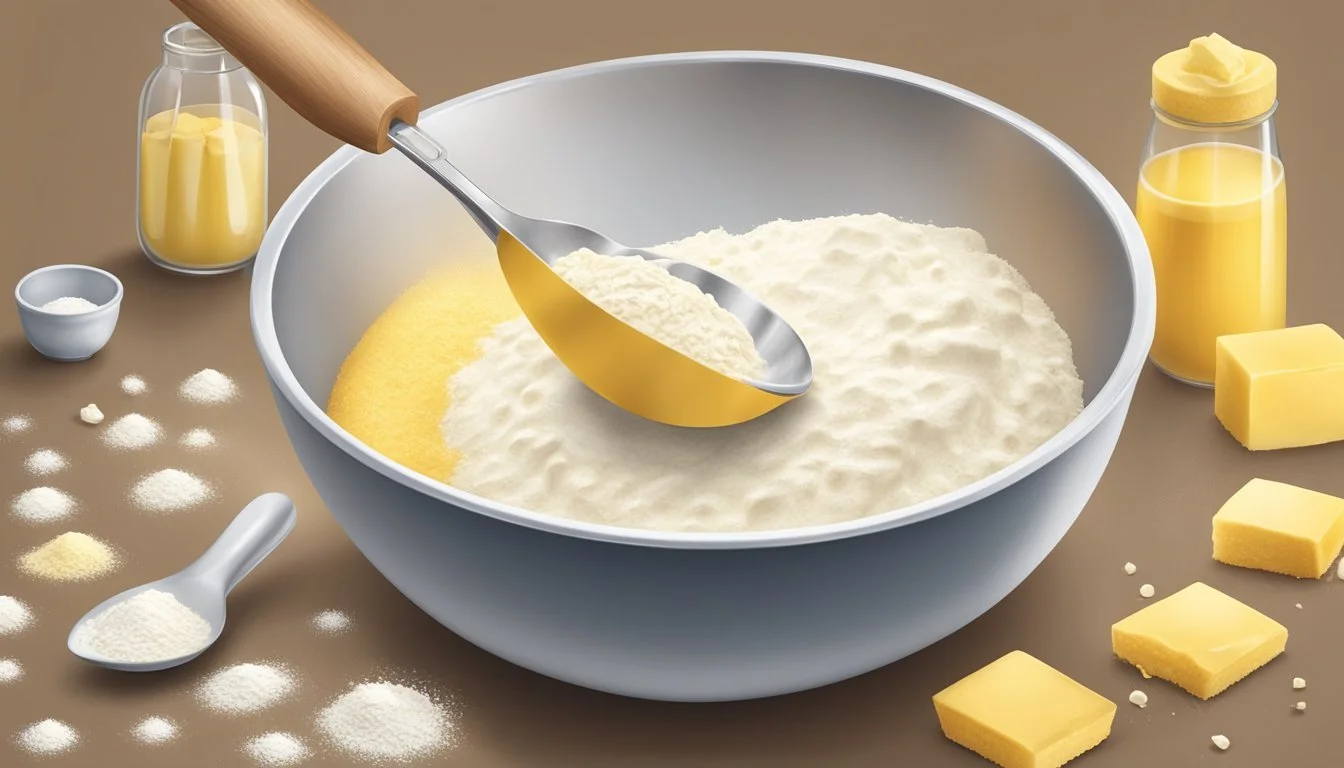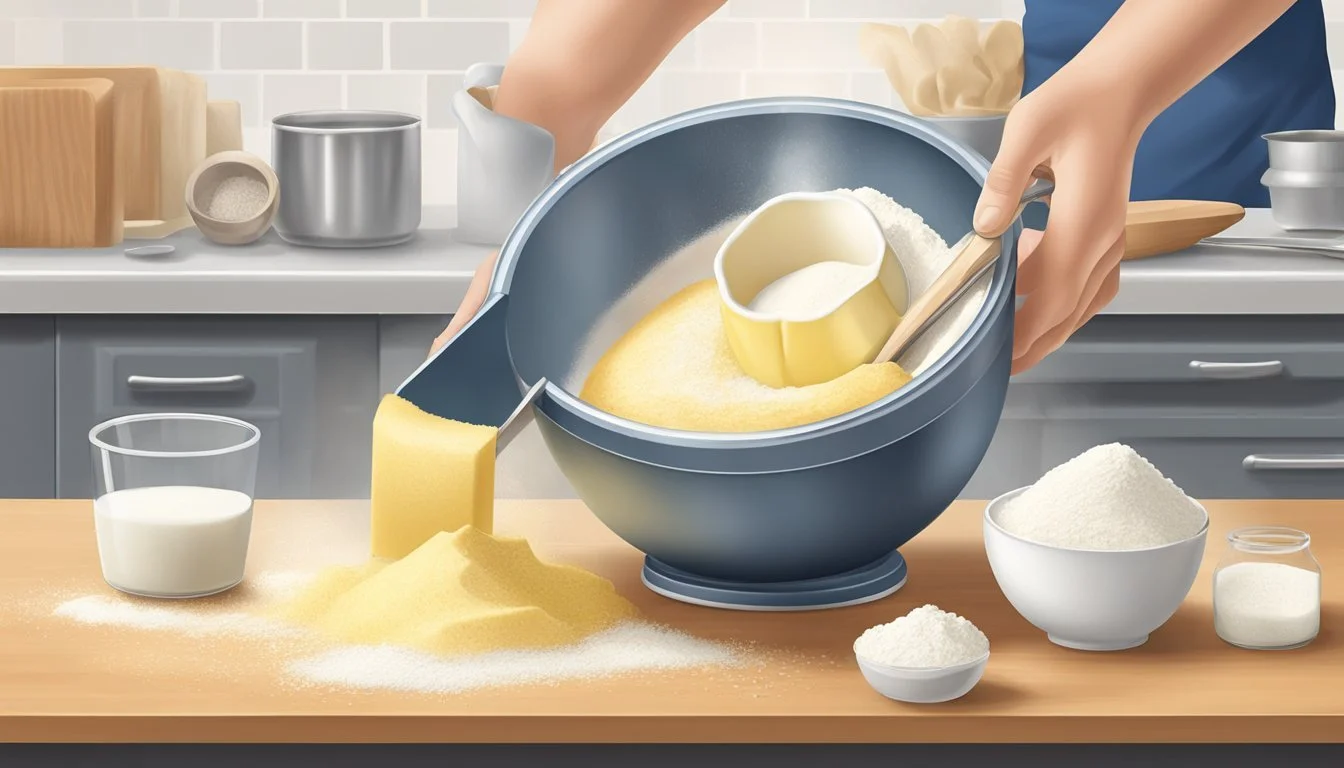How to Measure Ingredients for a Homemade Biscuit Topping
Precision for Perfect Results
Creating homemade biscuits with a flaky, golden crust that complements a rich, savory pot pie or a hearty casserole requires precision in measurement. For any biscuit recipe to be successful, the balance of dry and wet ingredients has to be just right. These dry ingredients commonly include flour, baking powder, and salt, which form the structural foundation of the biscuit, while the wet ingredients often consist of milk or buttermilk and fat like butter or shortening, which contribute to the tenderness and richness.
The quality of homemade biscuits hinges on the technique of incorporating cold, solid fat into the dry ingredients, which should be done before adding any liquids. This method, referred to as "cutting in," aerates the flour mixture and creates pockets of fat that steam during baking, giving rise to tender, layered biscuits. When it's time to add the wet ingredients, a light hand is essential to prevent overworking the dough, which can result in tough biscuits.
Measuring ingredients accurately is critical, as too much flour or not enough leavening agent can prevent the biscuits from rising properly. Using a scale is recommended for flour, as it ensures consistency that cup measurements cannot guarantee, especially considering the compaction that can occur with scooping. Liquids should be measured in clear measuring cups at eye level to ensure the correct amount is added, and it’s often beneficial to add the liquid incrementally. This approach allows the baker to achieve the desired dough consistency, with variables like humidity and flour type in mind.
Fundamentals of Biscuit Dough
Crafting the perfect homemade biscuit topping hinges on a meticulous balance of ingredients and technique. This section dissects the critical steps from selecting quality components to the nuances of dough consistency vital for creating tender, flaky biscuits.
Choosing the Right Ingredients
The foundation of a scrumptious biscuit starts with high-quality all-purpose flour. This serves as the structural base. Baking powder provides lift, while salt enhances flavor. A hint of sugar can be added for a subtle sweetness. For moisture and richness, buttermilk or milk are preferred, with buttermilk offering a slightly tangy edge.
Creating the Dough Base
Combine the dry ingredients thoroughly to ensure an even distribution. Once the all-purpose flour, baking powder, salt, and potentially sugar are mixed, make a well in the center. Pour in the chosen liquid, whether it be milk or buttermilk, to initiate the wet base for the dough.
Understanding Dough Consistency
When combining wet and dry ingredients, the dough should be slightly sticky. It is critical to avoid an overly wet or crumbly mixture. If the dough is too sticky, it's challenging to handle, while too dry of a mix won't yield the desired tender biscuits.
Incorporating the Butter
For flaky layers, use cold butter or even frozen, and cut it into small cubes or grate it. This can be blended into the dry mixture using a pastry blender or two forks until it resembles coarse crumbs. Cold butter is key, as it steams during baking, creating those coveted flaky layers.
Mastering the Kneading Technique
Once the butter is incorporated, gently knead the dough. Minimize handling to prevent warming the butter. Over-kneading can lead to hard biscuits, so a light touch is imperative for a tender result. Knead just enough to bring the dough together into a cohesive mass.
Rolling and Cutting Biscuit Dough
Roll out the dough on a floured surface to about 1 inch thick. Uniform thickness ensures even baking. Use a biscuit cutter for consistent shapes and sizes, pressing straight down without twisting to avoid sealing edges, which could impede the rise. A straight cut encourages lofty biscuits.
Prepping for the Oven
Arrange the biscuits on a baking sheet with little to no space between them for support as they rise, which can enhance their loft. Before entering a preheated oven, some recipes may call for brushing the tops with melted butter for a golden finish. Biscuits should be baked until they've risen and are golden brown on top. Once baked, place them on a rack to cool slightly before serving. Unused dough can be stored in an air-tight container and refrigerated for short-term use or frozen for later baking.
Making the Biscuit Topping
Creating the perfect biscuit topping involves selecting high-quality ingredients and combining them correctly before applying them to your biscuits. Whether for sweet strawberry shortcake or savory pot pies, the topping can enhance the overall dish.
Selecting Topping Ingredients
The choice of topping ingredients depends on the final flavor profile desired in the homemade biscuit recipe. For a sweet topping, selections might include jam or jelly, fresh fruits, or honey. For a savory topping, ingredients such as cheese or sausage gravy could be considered. When making homemade buttermilk biscuits, simple ingredients like flour, baking powder, and butter form the foundation.
Sweet Toppings:
Jam or Jelly: Use fruit preserves for added sweetness.
Honey: Drizzle on top for a natural sweetener.
Savory Toppings:
Cheese: Sprinkle grated cheese for a melt-in-your-mouth experience.
Sausage Gravy: Ladle thick gravy over biscuits for a hearty meal.
Combining Topping Components
In a mixing bowl, one should carefully combine the dry and wet ingredients to form the desired consistency for a biscuit topping. A proper mixture ensures that the topping is even and consistent.
For Sweet Biscuit Toppings:
Mix jam or honey with a bit of water or juice to make a glaze.
For strawberry shortcake, gently toss sliced strawberries with sugar and let sit to create a syrup.
For Savory Biscuit Toppings:
Blend softened butter with herbs and spices for a flavorful spread.
Whisk together a roux and stock to create a thick gravy.
Applying Toppings to Biscuits
One must apply toppings to biscuits with care to not overwhelm the delicate layers of the pastry. It is important to consider the temperature of the biscuits; for example, applying honey butter to warm biscuits will allow it to melt and soak into the layers.
Sweet Applications:
Layer jam and whipped cream between split biscuits.
Drizzle or brush syrupy fruit toppings over biscuits just before serving.
Savory Applications:
Spoon warm sausage gravy generously onto split biscuits.
Sprinkle grated cheese and return to the oven for a bubbly, golden finish.
Variations in Biscuit Toppings
Variety in biscuit toppings offers the opportunity to cater to different tastes and occasions. One may also consider if the toppings are meant to be served immediately or if they need to freeze well for future use.
Sweet Variations:
Swap jam with lemon curd for a tart contrast.
Mix seasonal fruits with sugar for a quick and refreshing topping.
Savory Variations:
Experiment with different cheese blends, like sharp cheddar or smoked gouda.
Add caramelized onions or mushrooms to sausage gravy for more depth.
Baking Tips and Techniques
In this section, dedicated to mastering the art of biscuit toppings, one will learn about the crucial aspects of oven temperature, baking aids, achieving the perfect browning, and solving common issues that can arise during baking.
Oven Temperature and Timing
To ensure that biscuits achieve a perfect golden crust, it is important to preheat the oven to the right temperature. Most biscuit recipes require an oven to be preheated to around 425°F (218°C). Timing is equally critical; biscuits generally bake for 10 to 15 minutes. Utilize an oven thermometer to verify the accuracy of your oven's temperature setting.
Using Baking Aids
For evenly mixed biscuit dough, tools such as a pastry cutter can be very effective in cutting butter into the flour without creating unwanted warmth from the hands. A sprinkling of flour on the dough and cutter prevents sticking, ensuring a clean cut each time.
Pastry Cutter: Essential for incorporating cold butter into the flour.
Flour: Lightly flour the surface to prevent stickiness.
Achieving the Perfect Brow
To attain that desirable golden brown appearance on top of your biscuits, they should be baked just until they reach that color. If the biscuits are browning too quickly, tent them with foil. Baking powder can also influence browning due to the Maillard reaction, which is responsible for the color and flavor development in baked goods.
Golden Brow: Biscuits should be golden on top but not overbaked.
Baking Powder: Use the right amount for proper rise and coloration.
Troubleshooting Common Issues
Biscuits not rising? Check that your baking powder and baking soda are fresh. Clumps in the dough? Sift your dry ingredients to ensure a smooth texture. If you don't have buttermilk, create a substitute by adding a tablespoon of vinegar or lemon juice to a cup of milk and let it sit for 10 minutes.
Clumpy Dough: Sift dry ingredients to remove lumps.
Buttermilk Substitute: Acidulate milk with lemon juice or vinegar.
Serving and Pairing Biscuits
Biscuits offer a unique versatility that makes them perfect for various pairings and occasions. Knowing ideal accompaniments can elevate their taste, and including biscuits in different meals throughout the day can add a comforting touch.
Ideal Accompaniments
When serving biscuits, they can be enhanced with the right condiments and sides. Traditional toppings such as gravy are perfect for a rich, savory experience. Jam, honey, and syrup offer a sweet counterpart that complements the buttery flavor of biscuits. Here are some specific pairings:
Gravy: A classic, creamy sausage or bacon gravy pairs well with warm biscuits.
Jam: Fruit jams like strawberry or peach add a sweet and tart contrast.
Honey: Ideal for those who enjoy a milder, natural sweetness.
Syrup: Maple or fruit-flavored syrups can be drizzled for extra indulgence.
Biscuits in Different Meals
Biscuits can be a staple across all meal times. During breakfast, they form the foundation of hearty breakfast sandwiches filled with eggs, sausage, or bacon. For lunch or dinner, biscuits act as a complementary side to stews or steamed vegetables. Biscuits and gravy, a beloved southern dish, combines a rich, meaty gravy with soft, flaky biscuits, often enjoyed as a filling breakfast or brunch option.
Storing and Preservation Techniques
To ensure the longevity and quality of homemade biscuit toppings, proper storage and preservation are critical. These techniques govern both the freshness of biscuits after baking and the best practices for freezing and reheating.
Keeping Biscuits Fresh
Once biscuits cool completely, one should transfer them into an air-tight container. This could include resealable plastic bags or containers made of plastic or metal. When using bags, expelling as much air as possible before sealing them protects the biscuits from moisture and staleness. For maintaining optimal freshness, it's advisable to store the biscuits at room temperature in a cool, dry place, away from any sources of heat or direct sunlight.
Freezing and Reheating Tips
If one intends to keep biscuits longer than a few days, freezing offers an excellent option. Biscuits should be placed in an air-tight container or wrapped securely in plastic wrap before going into a freezer-safe bag to prevent freezer burn. To maintain the flavor and texture of buttermilk biscuits or any other variant, reheating is best done in an oven. Preheat the oven to 350°F (175°C), and place the frozen biscuits on a baking sheet for about 15 to 20 minutes or until they're thoroughly warmed.
Procedure Description Wrap Individually Wrap each biscuit in plastic wrap and place in a freezer bag. Remove Air Squeeze out excess air from the freezer bag to preserve quality. Label and Date Mark the contents and date to monitor freshness.
Step Action Preheat Oven Set the oven to 350°F for preheating. Bake Place biscuits on a tray and heat for 15-20 min.
Nutrition and Dietary Options
When it comes to crafting a homemade biscuit topping, it's crucial to consider the nutritional content and to explore alternatives that cater to different dietary needs while maintaining taste and texture.
Understanding Biscuit Nutrition
Biscuits are typically high in calories and carbohydrates due to the flour and fat used in their preparation. A standard homemade biscuit roughly contains between 150-250 calories, with variations depending on the size and ingredients used. Nutrition plays an important role, as biscuits can also provide certain micronutrients, depending on the flour and added ingredients. For example:
Whole wheat flour increases the fiber content
Buttermilk contributes to the tangy flavor and tender crumb while adding some proteins and calcium
However, it's important to consider portion sizes and the overall context of an individual's diet to maintain balance.
Exploring Healthier Variations
To reduce calorie content or modify homemade biscuits for special diets, one can experiment with various ingredient swaps:
Replace traditional white flour with whole wheat flour to increase fiber and nutrient density.
Use a buttermilk substitute like a blend of milk (dairy or non-dairy alternatives) with an acid (lemon juice or vinegar) to cater to lactose intolerance or a vegan diet.
By exploring these options, one can create nutritious and delicious biscuits that suit a variety of dietary preferences.
Recipes and Variations
In this section, we will explore a variety of biscuit recipes ranging from traditional classics to inventive flavor combinations. These recipes include variations suitable for differing culinary uses such as toppings for cobblers or bases for strawberry shortcake.
Classic Homemade Biscuit Recipes
The foundation of any good biscuit starts with a simple, easy biscuit recipe. A basic biscuit typically requires five ingredients: flour, baking powder, butter, milk, and a pinch of salt. For a richer flavor, one can replace regular milk with buttermilk to make tender buttermilk biscuits.
Ingredients for Classic Buttermilk Biscuits:
2 cups of flour
1 tablespoon of baking powder
1 teaspoon of salt
1/2 cup of cold butter, cubed
3/4 cup of buttermilk
Instructions:
Preheat the oven to 425°F.
Combine the dry ingredients.
Cut in the butter until the mixture resembles coarse crumbs.
Stir in buttermilk just until moistened.
Turn onto a floured surface and knead gently.
Roll out and cut with a biscuit cutter.
Place on baking sheet and bake until golden.
Creative Biscuit Flavor Combinations
There's room for creativity when adding flavor to biscuits. By incorporating ingredients like cheddar cheese, chives, or garlic into the dough, biscuits gain an additional savory element that pairs well with meals.
Example Variations:
Cheese Biscuits: Add 1 cup of shredded cheddar cheese to the dough.
Herb Biscuits: Add 2 tablespoons of finely chopped herbs such as chives or parsley.
Garlic Biscuits: Add 1 tablespoon of crushed garlic or 1 teaspoon of garlic powder to the mix for a pronounced garlic taste.
Incorporating Biscuits into Dishes
Biscuits are versatile and can be used in various dishes. For a heartwarming breakfast, one could serve them smothered in gravy for a classic biscuits and gravy dish. Alternatively, biscuits can act as a base for strawberry shortcake or as a crumbly topping for a fruit cobbler.
Biscuit-Based Dishes:
Scones: Modify a biscuit recipe by adding sugar and egg to the dough, then shape into a round and cut into wedges before baking.
Cobbler Topping: Make biscuit dough with additional sugar, drop roughly onto fruit filling, and bake until golden brown.
Casserole Topping: Layer biscuit slices on top of a savory casserole before baking to add a comforting, doughy texture.


